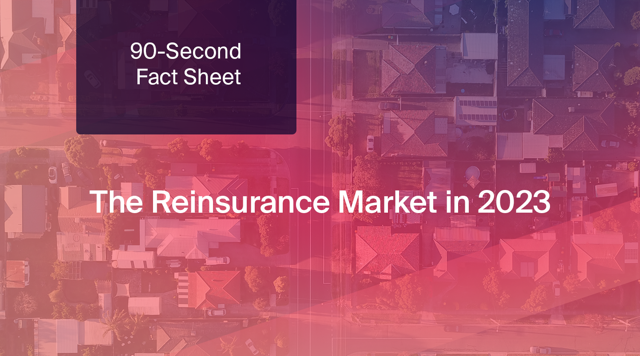Reinsurance rates are spiking to an all-time high. Fitch estimated a 20-60% rate increase for cedants in the overall property reinsurance market at the January 1st renewals.1 Terms and conditions are also tightening - many reinsurers are limiting their cedants to much higher attachment points2, or exiting CAT-exposed lines altogether
The main drivers for uptick in reinsurance rates
Our research has found three drivers underpinning the trend:
1. Devastating CAT losses, particularly from secondary perils
59% of all CAT losses come from secondary perils3, and those losses have caused major shifts in the reinsurance landscape. Howden estimates that global property CAT reinsurance rates were up 37% at the January renewals4.
2. A new urgency to improve return on capital
“When the cost of capital is equal to the rate of return, something has to change.” - Aditya Dutt, CEO of Aeolus Capital Management5. The reinsurance industry has underperformed since 2017, with an average return on equity of just under 5%6. Poor underwriting performance was a key driver, with an industry average 101% combined ratio over the same period7. Reinsurers are poised to use the tightening market as a chance to improve performance, with Fitch forecasting a 4pp underwriting margin expansion for reinsurers in 20238. Unfortunately for primary insurers, Goldman Sachs predicts that the same tightening market will create significant volatility for cedants9.
3. Value erosion in reinsurer investment portfolios
Macroeconomic factors are driving significant unrealized investment losses for reinsurers, particularly on fixed income portfolios due to rising interest rates. Aon estimates that these investment portfolio losses drove a 17% decline in global reinsurance capital across the first 9 months of 2022, with some players reporting equity value losses as high as 40-50% over that period10. Reinsurers will look to shore up these losses with better underwriting performance, which likely means tougher rates for primary carriers.
How property insurers can improve their odds with AI-powered predictive climate and property risk platforms
These factors mean that primary insurers can expect challenging reinsurance negotiations at the June 1st renewal deadline, particularly on property lines. However, new AI-powered predictive climate and property risk platforms can improve the odds for property insurers in three areas:
1. Rapid improvements in risk mitigation
Implementation-free portfolio reviews can quickly drive major loss ratio improvements.
2. Turn the tables of CAT risk screening in your favor
Improving data quality can lead to more favorable stochastic model portfolio screens, particularly with insight about the roof.
3. Enter the room as a leader in cutting-edge risk practices
Showing the same commitment to new technologies as industry leaders can help cedants build a better case.
Conclusion
With the right mitigation action and a cutting edge view of portfolio risk, cedants can navigate the upcoming 6/1 renewal successfully.
Learn more about how an AI-powered predictive climate and property risk platform can help you.
------------------------------------------------------------------------
Sources
1 & 8 - Fitch, Reinsurers’ Underwriting Margins to Expand by 4pp in 2023
2 & 3 - Gallagher Re, Gallagher Re Natural Catastrophe Report 2022
4 - Howden, Howden’s renewal report at 1.1.2023: The Great Realignment
5 - AM Best, Reinsurance: Roundtable Discussion on Renewals and What 2023 May Hold
6, 7 & 10 - AON, Reinsurance Market Dynamics
9 - Reinsurance News, Hard market to increase volatility for primary insurers: Goldman Sachs
